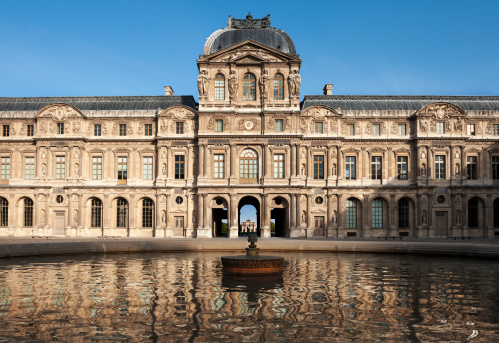
Paris Museums Beyond the Louvre
 For art lovers, Paris is the ultimate. Few cities in the world can match the breath and depth of art collections on view in the city. Unfortunately, most travelers limit themeselves to the Louvre and/or Orsay museums. Don't get me wrong, both are superb art institutions, in a class by themselves. You can easily spend a week at the Louvre and never visit the same room twice. But for anyone interested in art who has seen these collections and wants to explore further, here is an opinionated short survey. Before I start, I don't have to tell you that both Louvre and Orsay are mobbed, permanently, especially the most popular collections (Impressionist art at the Orsay, Mona Lisa and other highlights at the Louvre). One option to suggest to your clients who want to avoid the crush of the crowds is to visit in the evenings. The Louvre is open until 945pm on WED/FRI nights, and the Orsay is open until 945pm on THU.
For art lovers, Paris is the ultimate. Few cities in the world can match the breath and depth of art collections on view in the city. Unfortunately, most travelers limit themeselves to the Louvre and/or Orsay museums. Don't get me wrong, both are superb art institutions, in a class by themselves. You can easily spend a week at the Louvre and never visit the same room twice. But for anyone interested in art who has seen these collections and wants to explore further, here is an opinionated short survey. Before I start, I don't have to tell you that both Louvre and Orsay are mobbed, permanently, especially the most popular collections (Impressionist art at the Orsay, Mona Lisa and other highlights at the Louvre). One option to suggest to your clients who want to avoid the crush of the crowds is to visit in the evenings. The Louvre is open until 945pm on WED/FRI nights, and the Orsay is open until 945pm on THU.
Here are some of my favorites, in no particular order:
Musee Marmottan. This is a small museum, located in a mansion on the 16th district of Paris. It houses the best collection of Monet paintings, as well as an excellent gathering of impressionist and post-impressionist art. The collection was the brainchild of Jules Marmottan, a wealthy industrialist. It brings together his own collection, added to the collection of Michel Monet, the artist's own son, plus the collection of Mr De Bellio, who was an amateur artist and doctor to many impressionist artists. Many artists could not pay the bills, so they gave the good doctor a painting or two instead, and thus the collection began to take shape. At the moment, most of the collection is in storage as the museum is showing the art of Henri Cross, a post-impressionist pointillist artist and a student of Seurat. This show runs until February 2012, when the Marmottan collection goes back on view. Check the museum's website to know for sure what is on view. To reach the museum by metro, take the 9 Line to La Muette station. (Right bank, 16th district of Paris)
Musee Jacquemart-Andre. This museum is housed in a stunning 19th century private palace. It holds the private collection of Mr and Mrs Jacquemart-Andre, a wealthy couple who devoted their lives to art collection and appreciation. The palace is unbelievably beautiful, and so is the art, mostly 17-18th century French, Italian, British artists. Do not miss the Italian galleries, originally private and for the viewing pleasure of the Jacquemart-Andres only. To reach the museum, take the Metro to either Miromesnil or St Agustin stations. (Right bank)
Musee des Arts Decoratifs. This museum is located next to the Louvre and the entrance is on 107 Rue de Rivoli. This museum has over 150,000 objects in storage, including furniture, glass, ceramics, fabric, and all kinds of applied arts. ON view are 6,000 or so of the most beautiful objects, displayed by time period, chronologically. If you want to get a sense of what life in France was like from the Middle ages to the 20th century, this museum delivers one stunning interior after the next, including rooms worthy of Louis XIV, Art Nouveau, Art Deco, the 40s, the works. The strongest galleries are the 19th and 20th century-related displays. To reach the museum take the Metro #1 Line to Palais Royal/Musee du Louvre stop.
Musee Guimet. this is, without a doubt, one of the top collections of Asian art in the Western world. The collection was launched by Emile Guimet, a wealthy business tycoon from Lyons, who had a passion for Egyptian and Asian art. In the 1870s Mr Guimet traveled around the world, visiting ancient sites and collecting art along the way. This coincided with France establishing colonies in Indochina. The museum first opened in Lyons, then moved to Paris. Eventually, Mr Guimet gave the Louvre his Egyptian collection, traded it for the Louvre's Asian art, and everyone was happy. The museum has an outstanding presentation of the art of Vietnam, Thailand, Burma, Cambodia, and other Asian countries. Some of the best sculpture and statues from Angkor Wat are displayed here. To reach the museum, take the 9 Metro to Place d'Iena or ALma-Monceau stop.
Musee Du Quai Branly. This museum, inaugurated about 5 years ago, is devoted to so-called 'non-western' art, that is to say, the art of Pre-Columbian Americas, Africa, Oceania, etc. The collection of art includes diverse objects such as gold masks from Peru, totem poles from Western Canada, monumental statue from Easter Island, ceremonial masks from deepest Africa, and much more. The art is presented in a very innovative, interesting way, and is housed in a stunning ultra-modern building designed by Jean Nouvel. The museum sits in the shadow of the Eiffel Tower on the left bank, but is best reached by Metro by getting off at Alma Marceau (right bank) on the 9 line, and walking across the bridge to the museum. I had not seen this museum until Last Sunday, and I was really impressed. Note - there is a temporary exhibit on the Maoris and another on Japanese samurai, that has long lines. If you only want to see the museum's collections ask for a ticket to the 'collection permanente' and walk right in.
Museum Pass. If your clients are going to see multiple museums and monuments in a few days, you may want to buy a Museum Pass, available at most museums' ticket window or at major metro stations like Place de la Concorde. The museum pass cossts 35E for 2 days of unlimited visits, 50E for 4 days, and 65 E for 6 days. Keep in mind most museums these days cost 10-12E each, so the pass is indeed a good buy if you plan to visit several places over 2-4-6 days. THe pass also gets you into Versailles, the Arch of Triumph's viewing platform, etc.
Getting around. By far, the Metro is your best bet. Clean, convenient, and safe, Metro is absolutely the way to go. To save money and time, buy a 'carnet de dix billets' which will give you 10 tickets at once, and save you money over individual ticket purchases -- not to mention you will not have to stand in line for each ride.
